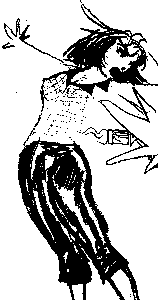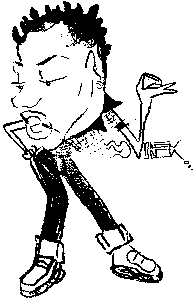 Why is a city renowned for individuality so restrained in fashion?
Why is a city renowned for individuality so restrained in fashion?
By Michael Stabile
Illustrations by Derek Jackson
I remember, during the New York stiletto epidemic of 1997, answering a call from a Gothamite who wanted to warn me of the coming plague. "But no one wears heels in this city," I countered, imagining women tumbling down Russian Hill like runaway cable cars. "It's just not possible here. San Franciscans cannot walk in six-inch, tapered-to-a-pinpoint heels."
She assured me that it didn't matter, because no one in New York could wear them either. Women were stumbling at such an alarming rate that ankle bandages were sure to supersede Gucci shoes as the footwear of fall. Although inconvenience and comfort have never inhibited fashion, a misplaced center of gravity is hard to overcome, and stiletto-heeled or not, San Francisco is often precariously off kilter. Like a special-needs child, San Francisco adopts fashion differently than do our siblings to the south and east.
It may be the weather of perpetual April that keeps us from jettisoning each chic in favor of the next--what does "last season" mean in a place where seasons are only vaguely discernible? And how does one wear linen before Labor Day in a city whose summer temperature stiffens in the low 60s? But London has overcome this obstacle to become a fashion center for both the street and the haute, leaving one to speculate that the reason we have such a death grip on leopard skin and ring-neck T-shirts is because no one, stylewise, is tending to us. It's as if Mother is no longer around to tell us we can't wear those dirty pants three days in a row. No one prods us to change.
When we do make a change--or more accurately, an addition--to our civil wardrobe (since no one seems to throw anything away, no matter how ratty), we do so tentatively, often one neighborhood at a time.
San Francisco's sporadic weather patterns inspire more than just head colds and a love of layering; they foster the development of fashion microclimates. The Mission eschews the tattered sweaters and turtlenecks of the Lower Haight, in part because such clothing isn't viable when confronted by the district's direct sunlight and retarded fog. Instead, well-worn T-shirts, Chinois-print slides and sidewalk bazaar sunglasses dominate the coffeehouse catwalk of Valencia Street.
Whereas New York fashion reinvents itself every year, even if only tilting along the standard axis of minimal/decadent, street/couture and natural/illusory, San Francisco fashion merely dictates the citywide embrace of one or two pieces a year. Last year, it was the bootleg pant and the neck-kerchief.
 This year, it's the omnipresence of capri pants/pedal pushers and the denim-cuffed jeans on Market Street. Hayes Valley, the oft-proclaimed yet seldom-realized epicenter of style, can take credit for the popularization of the former. Duboce Triangle, a neighborhood comprising a few blocks located just a couple of blocks away from several actual neighborhoods, can claim credit for the latter.
This year, it's the omnipresence of capri pants/pedal pushers and the denim-cuffed jeans on Market Street. Hayes Valley, the oft-proclaimed yet seldom-realized epicenter of style, can take credit for the popularization of the former. Duboce Triangle, a neighborhood comprising a few blocks located just a couple of blocks away from several actual neighborhoods, can claim credit for the latter.
It's no accident that both of these hot, new and stylish neighborhoods have been, until recently, none of these things. Not so much neighborhoods as intersections, they have possessed the same advantages that once belonged to disparate areas such as Istanbul and Shanghai. All began by borrowing, stylistically, from the interlopers who once only used them as stopovers. Eventually, each evolved into a kind of fusion neighborhood, whereupon residents developed a unique sense of style inspired by the variety of influences to which they had been exposed.
This success of capri pants in Hayes Valley this summer might as well have been preordained. Gaining street credibility from the bordering Lower Haight and Civic Center, yet accessible (safe, with ample parking) to the tonier denizens of the Upper Fillmore/Lower Pacific Heights shopping district, Hayes Valley can mix jet-set au courant with thriftability.
Capri pants, which can top off at about $120 a pair, look good on no one but go quite well with the ever-popular Pulp Fiction bangs of four years ago. Within weeks of their appearance on Hayes Street, they have been embraced by women from the Castro to the Mission to the Marina. Weatherwise, pedal pushers are ideal--not shorts (too cold) not pants (too hot); it's a wonder San Franciscans hadn't thought of them before. But such is the clarity of fashion hindsight.
The cuff, a throwback to rockabilly and teddy boys, is capitalizing on the denim obsession of the Castro and the cheap chic of the Mission and Lower Haight. After a successful stint in New York (well over a year ago), the cuff has found a new home in the residential borderland of Duboce Triangle. Not coincidentally, this was a move that did not require a new purchase.
Sure, there were the serial Levi's ads with Beastie Boy-loving grannies to jump-start the trend, but most fashionistas needed only to roll the cuffs on their boot-cut (if they're not too wide) or straight-legged dark denim pants from seasons past. Given the geographically specific vogue of San Francisco, it's fitting that a neighborhood with very little retail should be the first to embrace a fashion for which a store is not requisite.
As evidenced by our never-fading fascination with the slip dress or bobbed hair, it's unlikely that San Francisco will give up the cuff or the capri anytime soon--like the fog, fashion lingers. In the meantime, we can only look for next season's blockbusters and hope that they take our mind off our lack of a new wardrobe. Designers in both New York and Paris have been really keen on the cape as the look for fall. Easy for them to enjoy. The fashion bug they catch is gone after only one season--San Francisco gets it as a lifetime illness.
[ San Francisco | MetroActive Central | Archives ]
![[MetroActive Arts]](/arts/gifs/art468.gif)